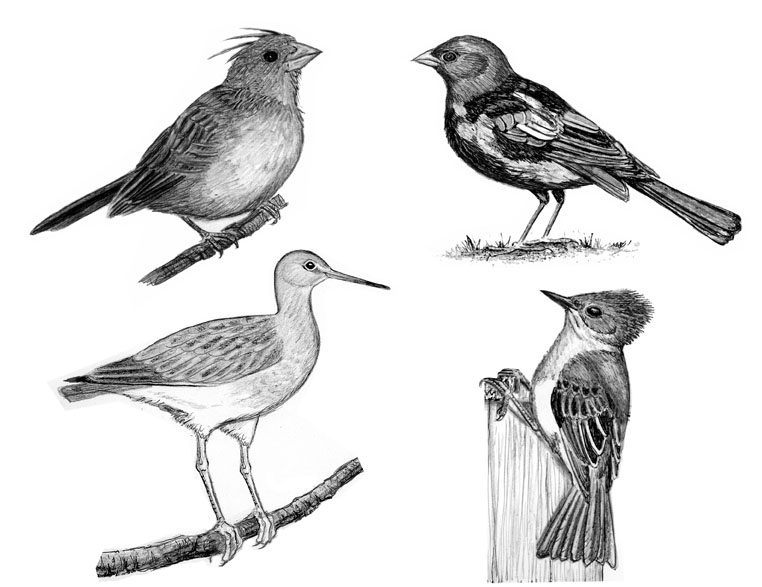
Dear Bird Folks,
Could you please tell us what bird is in the attached photo? It looks like a giant titmouse.
– Jeff, Kingston, MA
No problem, Jeff,
I’ll be glad to help identify the bird in your photo. And while I’m at it, I’ll also identify a handful of other mystery bird photos that folks have sent in recently. I’m going to call this column “Mystery Bird Monday,” even though it’s not Monday. I thought about calling it “What is it Wednesday” instead, but it’s not Wednesday either, plus the phrase “what is it” is just too vague. In addition to birds, who knows what other photos I might receive? I’d rather not take any chances.
The bird in your photograph is a Northern Cardinal, one of the most beloved birds in North America. Some folks might be wondering how it’s possible that you didn’t even know what a cardinal looks like. Don’t worry, Jeff, this is not your fault. I blame the companies that publish those incomplete field guides. It’s one of my pet peeves, and I have a lot of pet peeves. But I’m not getting into that right now. We have too many mystery birds to identify. After all, it’s Mystery Bird Monday.
Even though they don’t look exactly alike, male and female cardinals have two things in common: they are both handsome birds, with bright orange beaks. But do you know what bird isn’t very handsome and doesn’t have a bright orange beak? (No, not a giant titmouse.) For the first few weeks of their lives, young cardinals are mostly light brown, with surprisingly dark bills. Aside from the head crest, they look less cardinal-like and more like, hey, a giant titmouse. (I can see that now.) As the summer wears on, young cardinals gradually molt out of their drab fledgling feathers and their beaks slowly turn bright orange. By the fall, the kids look like their parents (and like the images in those cheesy incomplete field guides).
Back in May, I received a photo of another bird that also has a large beak. It was a Rose-breasted Grosbeak. Once again, Rose-breasted Grosbeaks should be easy to identify, except the descriptive name only applies to males. Female grosbeaks are mostly brown and have none of the males’ markings. They do, however, have a bold white line above each eye, which helps with identification. They also have a gross beak, so at least part of their name is accurate.
Photos of this next mystery bird have been appearing in my inbox fairly regularly in recent years. I’m talking about Willets. Willets are large sturdy sandpipers that were once rare breeders in Massachusetts, but over the last few decades their numbers have increased dramatically. Each spring they are found on most Cape beaches, where they are both noisy and conspicuous. But unlike typical sandpipers that can be shy and quite active, Willets are somewhat sluggish and often allow for close approach, which explains how so many people are able to photograph them. Even with photographs and close viewing, identifying a Willet isn’t easy. The bird has basically zero field marks. The words most often used to describe a Willet are bland and dull; but that all changes the second they take flight. Willets now reveal bright bands of white on each wing. These white bands make the birds’ identity instantly obvious (at least it’s obvious to the people with complete field guides).
As opposed to the Willet, the Great-crested Flycatcher is loaded with field marks. It has a puffy gray crest, lemon yellow belly and rufous on the wings and tail. It is also, like the Willet, noisy and conspicuous. If there’s a Great-crested Flycatcher in your yard, you’ll know it…or maybe you won’t. In spite of the noticeable markings, I still receive regular photos from questioning people who are seeing an odd bird going in and out of a nest box. Not often thought of as a “birdhouse bird,” Great-crested Flycatchers are regularly attracted to old nest boxes, especially boxes that have had the entrance hole enlarged by squirrels. (See, there’s at least one creature in the country, besides me, that appreciates squirrels.)
I was just going to write about female Red-winged Blackbirds (which also are confusing birds, since they aren’t black and don’t have red wings), but before I could get started, I received two photos from two different people wanting to know about two “real big finches.” These mystery birds are actually Brown-headed Cowbirds. Young cowbirds start off life covered in brown streaks and indeed look like large female House Finches. By the end of the summer the females will lose their streaks and just become generic brown, like tiny UPS drivers. Meanwhile, the brown on the males will slowly molt into black. While they are transitioning, the birds have a rather patchy look, like somebody on one of those skin disease commercials.
I know some folks aren’t big fans of technology, Jeff, but I love that you and so many other people have a device with a camera. Identifying a bird from a vague description is tough, especially when the bird, usually a baby or a dull female (sorry, ladies), doesn’t have any obvious field marks. A photo makes my job much easier. Anyone with a strange photo can by all means send it my way, but only on Mystery Bird Monday. If it’s What is it Wednesday, don’t send me anything. I’m still nervous about what I might receive.